LED light bulbs g4 12v: features, selection rules + review of the best manufacturers
Miniature halogen illuminators are being replaced by energy-saving counterparts - G4 LED 12V light bulbs, which provide complete lighting.LED products have a lot of advantages and are the most promising light sources.
However, in order to maximize the expected potential of capsule light bulbs, you should wisely approach the issue of choice, taking into account the features of their operation.
We will help you solve this problem. The article describes the features of the operation and use of low-voltage lamps, presents a step-by-step algorithm for choosing a lighting fixture, and also identifies the best manufacturers of LED lamps.
The content of the article:
Design and principle of operation of G4 lamps
Among the general variety of diode light bulbs G4 modifications are distinguished by their minimal size, base shape and 12 V power supply. Due to their appearance, such illuminators are often called capsule illuminators.
The design of LED lamps, in general, and G4 diodes, in particular, is fundamentally different from analogues with incandescent filament or fluorescent products. There is no fragile glass or unreliable moving parts.
The main elements of an LED illuminator are: a transparent bulb, a module with LEDs, a radiator, a driver and a pin socket.
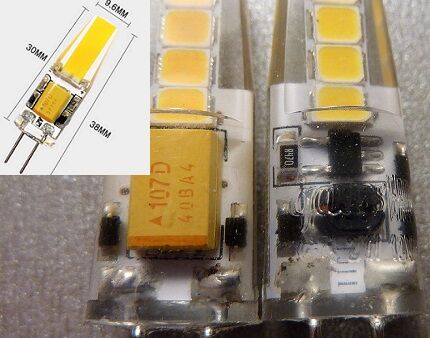
The mini-bulb operates according to the standard operating scheme of LEDs made from semiconductors.
When an electric current is applied, charged particles of dissimilar materials actively move, and upon contact they release photons - light is emitted.
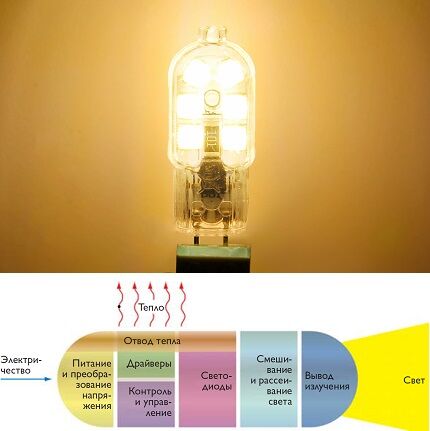
An important condition for the operation of 12 V light bulbs is the connection of a step-down transformer. The device is connected in front of the light source.
In addition to correcting the voltage to the desired value, the power supply converts alternating current to direct current.
Features of low-voltage illuminators
G4 12V lamps have all the main advantages of LEDs: economical energy consumption, durability, environmental friendliness and low heat dissipation. In addition, due to design differences, capsule illuminators have additional advantages.
One of the significant advantages can be considered their versatility. Compact dimensions allow the lamps to be installed in miniature lamps and used for illuminating ceiling structures, steps, furniture, interior decoration and zoning.
There is a high demand for “capsules” among car and motorbike enthusiasts – diodes are used in transport lighting systems.
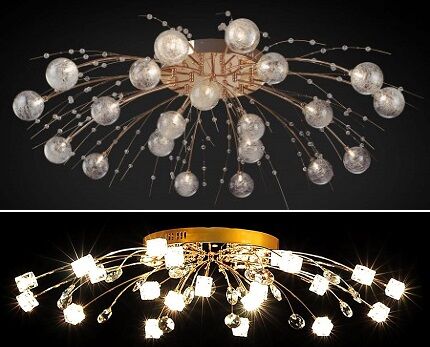
Despite the high initial investment, diode light bulbs fully pay for themselves - they last 15 times longer than their halogen counterparts.
Additional advantages of low-voltage LED illuminators:
- electrical safety. It is believed that 12 V electric current does not cause harm to humans.Therefore, low-voltage light bulbs are acceptable for installation in high-risk areas: swimming pools, saunas, cellars, etc.
- Instant on. The operation of the LED eliminates the ignition stage - the LED lamp immediately generates 100% luminous flux.
- Reliability. Capsule models are resistant to mechanical damage: scratches and chips.
LEDs with G4 socket are available in different shades of light - from neutral pale yellow to cool white with blue.
If we talk about the disadvantages of capsule models, we can highlight several significant disadvantages:
- High price. You will have to pay a lot to guarantee long-term performance. It’s definitely not worth saving on quality - the parameters of cheap Chinese analogues from unknown manufacturers do not correspond to the declared characteristics. Moreover, when using light bulbs with a low-capacity capacitor, there is a risk of its rupture.
- Increased current value – a consequence of low voltage. The length of the conductors needs to be adjusted. As the length of the wires increases, the resistance increases and the quality of lighting deteriorates.
To avoid dimming of the light bulbs, you need to check that the length from the power supply to the light bulbs is approximately equal, the permissible error is 2-3%.
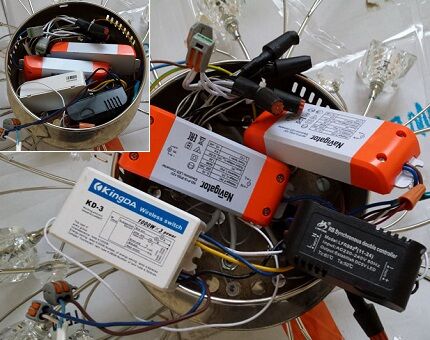
The place for the power supply needs to be thought out in advance; you may have to create some kind of niche for the equipment. In addition, the device has its own efficiency, due to which the lighting efficiency may decrease.
And the very presence of an additional link in the circuit increases the risk of failure of the entire chain.
Algorithm for selecting miniature LEDs
The range of 12 V G4 LED bulbs is very diverse. When determining the appropriate option, you need to understand the purpose and operational features of different types, as well as competently evaluate the basic characteristics of illuminators.
Variety of designs
The first priority is to choose the desired shape of the light bulb.
Among the low-voltage LED models with a 4 mm pin base, five types are mainly used in everyday life:
- capsules;
- corn;
- petals;
- candles;
- disk.
The first group is most in demand. The body has a cylindrical shape and is covered with a transparent or frosted bulb - a diffuser. Such products more often than usual act as a substitute halogen bulbs.
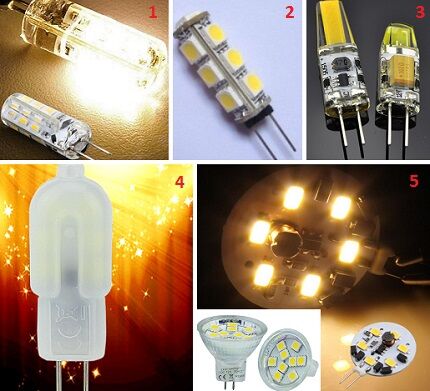
In corn, all the diodes are located on an open cylindrical platform. The absence of a bulb allows for brighter illumination and eliminates the possibility of overheating. Like a traditional capsule, corn is installed in chandeliers and lamps.
The main disadvantage is the unattractive appearance when turned off. The corn is selected so that the lampshade covers the light bulb itself.
The “petal” and “candle” models are more often used in vehicle lighting. However, they have also found their application in organizing home lighting - this is spot lighting, creating ceiling or wall luminous patterns.
Flat disk-shaped illuminators are used in luminaires designed to create a directional luminous flux.The illumination angle of the “tablets” is no more than 120°.
In addition to the form factor, low-voltage light bulbs differ from each other in their internal filling - the type of LEDs.
Three options are possible:
- SMD;
- COB;
- Filament.
SMD. Single semiconductor crystals coated with phosphor. The diodes are located on a heat-sinking printed circuit board.
The visible glow angle of one crystal is 20-140°. The main advantage of SMD LEDs is intensive heat dissipation and, as a result, durability.
COB. Structurally, a COB matrix is a set of crystals on one platform, filled with phosphor. Due to the tight fit of SMD diodes, a bright glow is achieved. COB lamps illuminate about 180-220°.
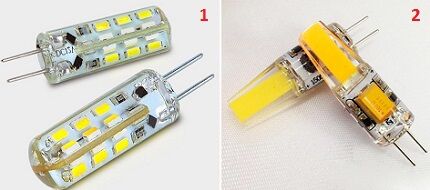
Filament. Has the most effective light parameters. Many crystals are installed on glass threads, which are then coated with a fluorescent solution. The main achievement of the technology is 360° illumination.

Taking light characteristics into account
Having decided on a suitable shape, you should evaluate the main parameters of the LED light bulb:
- power equivalent;
- light flow;
- glow temperature;
- color rendering quality;
- degree of pulsation.
Glow brightness LED light bulbs are characterized by two indicators: power equivalent and luminous flux. The parameters are interconnected.
Using the summary table, you can determine at what power different lamps achieve a certain level of luminous flux, expressed in lumens.
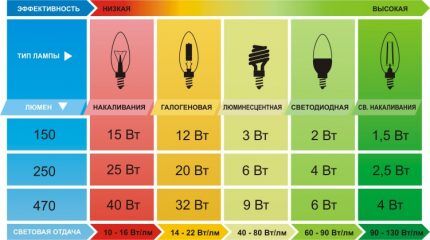
If you don’t have a comparison table at hand, you can rely on the manufacturer’s data - often the packaging indicates the amount of luminous flux and an analogue of power.
In case of lack of information, a rough guide will do: 10 W incandescent lamp corresponds to 1.5 W LED illuminator.
Glow temperature. An important parameter that determines the comfort of light perception and the quality of lighting of the surrounding space. Low-voltage LED lamps operate in the range of 3000-4500 K, which corresponds to neutral and daylight.
Habitual incandescent lamp creates a soft, slightly yellowish tint, LED models give a cooler tone.
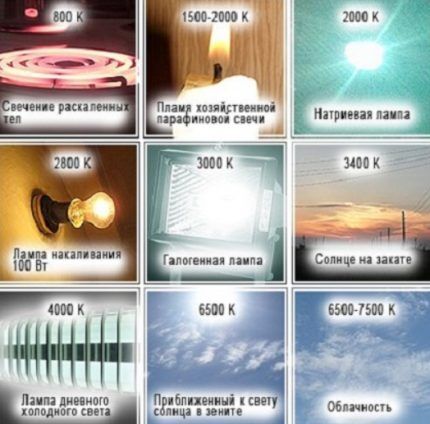
Choice color temperature depends on the purpose of the light bulb and its location. For the bedroom, it is better to choose products with an indicator of no more than 3000 K; for a child’s room, an LED of 3000-3200 K is suitable, and for decorating a work space - 3500 K or more.
Color rendition. Unfortunately, this characteristic is rarely specified by manufacturers of capsule light bulbs. But it is the color rendering index that largely determines the reality of perception of surrounding objects and one’s own reflection in the mirror.
The parameter is expressed in absolute units within 100 and is designated CRI.The reference indicator is sunlight, CRI=1. Incandescent lamps also give good results – CRI=97.
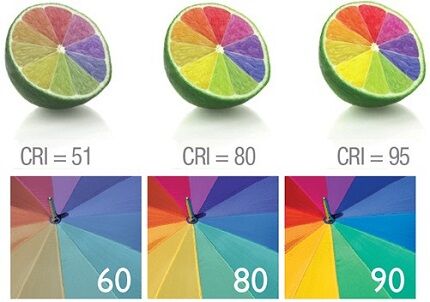
If the data is not displayed on the packaging, then the quality of color rendering is checked experimentally. Place your palm under the glowing light bulb; if it seems grayish, then the product is clearly of dubious quality.
Flicker of light. Another characteristic that manufacturers are in no hurry to share is the degree of pulsation. When working LEDs may flicker, creating significant strain on the eyes.
Immediately after switching on, the pulsation is not felt, but with such a glow a person gets tired faster, and vision may deteriorate.
To diagnose the defect, you need to look at the switched-on capsule through the smartphone camera. The presence of pronounced stripes indicates unacceptable flicker intensity.
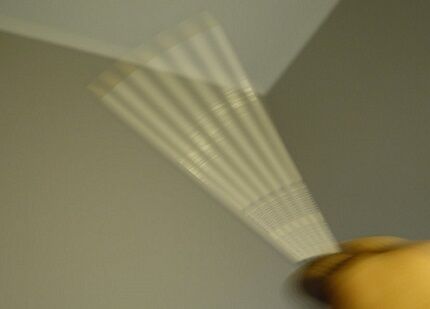
According to SNiP standards, the pulsation level for a home should be within 30%, and for workplace lighting - up to 20%.
A capacitor is responsible for smoothing out flicker in low-voltage LEDs. Whether the element will cope with its task depends on its capacity. For an LED lamp with a power of 1.2-2 W, you need a capacitor of at least 100 μF.
You can calculate the actual capacity of an element from its markings. Multiply the first two-digit number by the number encrypted in the third (6 means 1 µF, 7 - 10 µF). Letter marking is the operating voltage of the capacitor.
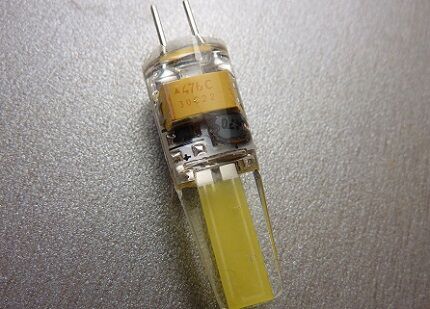
Additional selection criteria
When comparing light bulbs with the same characteristics, you should pay attention to their parameters.
Scattering angle. The value depends on the type of LED used and the shape of the lamp itself. The maximum illumination of 360° is provided by Filament models, the minimum by diodes on flat disks. When choosing, you need to start from the purpose of the lighting device.
Flask type. Models with matte and transparent diffusers are available for sale. The first ones create a soft glow and hide the filling of the lamp.
Matte bulbs are suitable for lamps with open shades. The transparent diffuser provides a brighter glow.
Housing material. For models with power over 2.5-3 W, dense silicone is mainly used. Mini lamps with a matte cap are made of polymers - polycarbonate and durable plastic.
The service life of a low-voltage LED illuminator is about 15-30 thousand hours. When choosing a diode, experts recommend taking into account an unspoken rule: the longer the warranty period from the manufacturer, the more durable the product.
For more information on the characteristics of LED light bulbs, see this article.
Review of products from the best manufacturers
The leadership position in the LED light bulb market is shared by two global brands: Philips (Netherlands) and Osram (Germany). The actual performance of lighting devices from European companies corresponds to the declared characteristics, and their service life is unrivaled.
Mini-bulbs of both brands, in comparison with analogues, win on many points: design, high level of color rendering, virtual absence of pulsations.
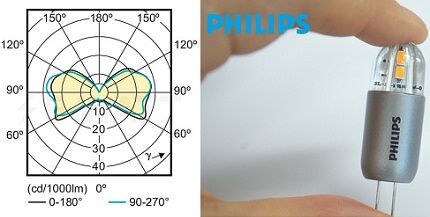
The mini-lamp from Osram – Star Pin G4 – has similar parameters.
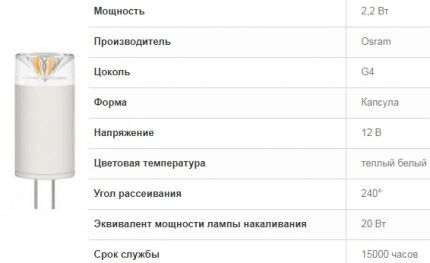
In addition to branded light bulbs, the market offers a wide selection of worthy analogues at a more reasonable price.
Recommended manufacturers include:
- Gauss (Russia) – the company constantly improves its products, using the latest technology and introducing design solutions;
- Maxus (China) – LED lamps with a power of 1-2 W, the company provides a 2-year warranty;
- Biom (China) – a wide range of different forms of low-voltage illuminators, excellent price/quality ratio;
- Foton Lighting (UK) - offers European quality light bulbs at a reasonable cost;
- Navigator (Russia) – the models use a highly efficient driver and planar LEDs with light transmission CRI>80; The manufacturer offers ceramic, silicone and polycarbonate cases.
You should definitely avoid products from nameless manufacturers. You should not count on the quality, durability and safety of their lamps.
Conclusions and useful video on the topic
Video report on testing various low voltage G4 LEDs:
Review of mini corn light bulbs from Foton:
LED illuminators with G4 socket are a worthy alternative to halogen light bulbs. Their use can significantly reduce energy consumption while maintaining high illumination levels.
In order for the transition to LEDs to have exclusively positive aspects, it is necessary to carefully approach the choice of mini-lamps.
Do you have anything to add or have questions about choosing low-voltage LED lamps? You can leave comments on the publication, participate in discussions and share your own experience of using such lamps. The contact form is located in the lower block.




Great article! Perhaps one of the best.
It would be nice to add about heat dissipation in ice lamps. After all, the lower the dissipation, the shorter the service life. Diodes in silicone last much less because... there is less heat dissipation. In expensive lamps, the manufacturer places one of the main emphasis on this.